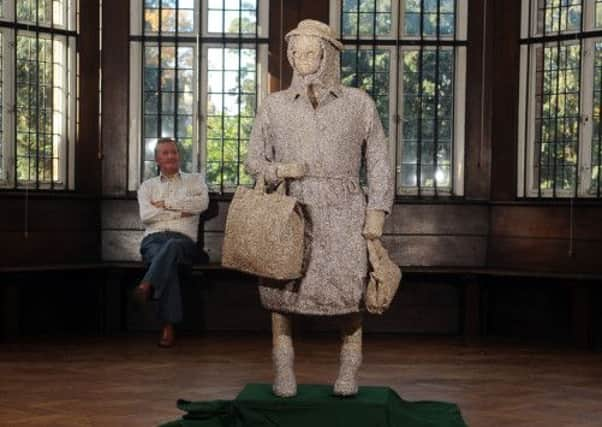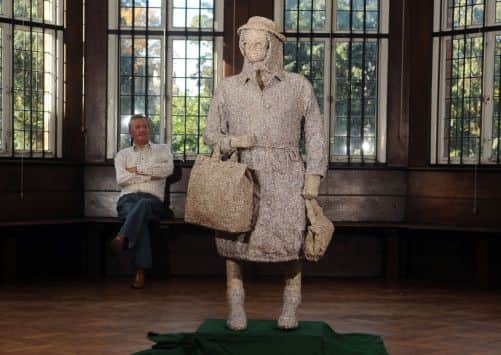Statue of note that really is one in a million


And now Eleanor Rigby has been turned into a sculpture by fellow Liverpudlian artist Leonard J Brown.
Like the 1966 original, with its themes of loneliness and isolation, Mr Brown’s version also carries a social message, being constructed entirely of used bank notes – £1m of them – to depict the relationship between wealth and poverty, wealth being the countless transactions the money saw before being shredded, and poverty in the form of Eleanor, who walked the streets and lived in a dream.
Advertisement
Hide AdAdvertisement
Hide AdBut although there is a serious side to his work, Mr Brown, who has lived in Hull for more than 40 years, has lost none of his Scouse accent, humour, or charm.


Recalling his prolonged conversations with staff at the Bank of England as he tried to persuade them to part with the cash, Mr Brown said: “I started at the top and worked my way down.
“I got passed around a lot then after probably two months they invited me down to collect the money.
“I sat in reception and they called my name, ‘Is Mr Brown the artist there please?’. There were people waiting for various appointments and they said ‘Have you come to paint a portrait of the governor?’.
“I said ‘I really can’t tell you’.
Advertisement
Hide AdAdvertisement
Hide Ad“Then two security guards came down with sackfuls of money – it was shredded but nobody knew – and said ‘We’ve got the notes ready for you Mr Brown’.”
He added: “You can imagine what they thought on the phone – ‘I’ve got a bloke here with a Scouse accent who wants a million pounds’.”
Given the subject and their shared roots, Mr Brown is hoping to gain Sir Paul’s backing for his statue, and is encouraged by his early discussions with his personal assistant.
Mr Brown said: “She said ‘You realise we get hundreds of requests every week but we are working through them and I think your sculpture is magnificent’.
Advertisement
Hide AdAdvertisement
Hide Ad“That led me to believe she would definitely pass it on to Paul,” said Mr Brown. “Maybe.
“It depends where he is in the world. I saw him on TV in America the other day and I don’t think he’s thinking about me.”
Should that meeting ever take place, the pair would be able to reminisce about old times, as their paths nearly crossed before.
Mr Brown, 70, enrolled at Liverpool College of Art in 1960, shortly after John Lennon, and just as the Beatles were creating the sound that would define a generation.
Advertisement
Hide AdAdvertisement
Hide AdAs a member of the same scene, Mr Brown, who has also worked as a musician, witnessed many of The Beatles’ legendary early performances at Liverpool’s Cavern Club. He said: “When you came out it was like you’d been in a coal mine, because it was basically in a cellar and there we were with our collarless suits and pointy shoes and there was all this stuff coming off the walls and ceilings because there were so many people in there.
“There was no health and safety in those days - the noise and heat were horrendous.”
As more knowledgeable Beatles fans will know, Eleanor Rigby was not the real name of the woman who inspired the song.
Mr Brown said: “When Paul McCartney was writing the song there was a bag lady in Liverpool who everybody knew called Daisy Hawkins, every city has got one, but he couldn’t sing Daisy Hawkins because it didn’t fit with the tune he’d got.”
Advertisement
Hide AdAdvertisement
Hide AdAlthough the Eleanor Rigby in the song may not have been homeless – famously keeping her face in a jar by the door as she waits by the window – Mr Brown has made her the first million-pound bag lady and the evidence of her wealth can be seen.
There is a purplish tinge from the £20 notes – there are £250,000 of them in the chest cavity alone – but the face and hat are darker, almost brown, being fashioned from huge number of “tenners”.
It is also possible to make out parts of serial numbers, £ signs, and other features of the notes, which were delivered in large cylindrical pellets.
“I offered to shred it myself but they didn’t buy that,” said Mr Brown.
“We have Sellotape parties in our house.”
Advertisement
Hide AdAdvertisement
Hide AdThe sculpture was unveiled yesterday at Beverley Art Gallery, where it will be on display until October 17, and its creator is hoping he will one day be able to see it exhibited in the home city of McCartney, Rigby, and Brown.
“My ultimate aim is to get it in the Tate Liverpool,” he said. “I’m sure she’d be quite at home in the Tate.”